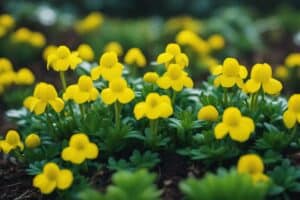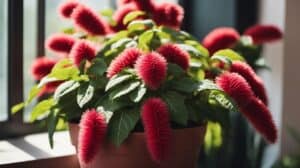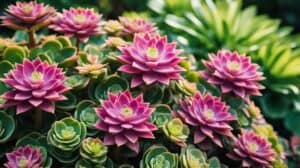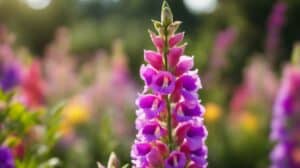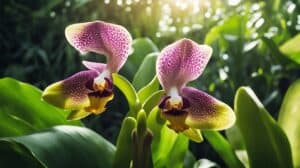Epidendrum Radicans, commonly known as the Fire-Star Orchid, is a stunning flowering plant that is perfect for beginners. This orchid is native to Central and South America, where it grows as an epiphyte on trees or as a lithophyte on rocks. It is a popular choice among orchid enthusiasts due to its ease of care, colorful blooms, and unique appearance.

The Fire-Star Orchid is characterized by its bright orange and yellow flowers, which resemble a starburst or firework. The plant typically blooms in the spring and summer months, and each flower can last up to several weeks. The orchid’s foliage is also attractive, with long, thin leaves that grow in a clumping habit. Additionally, Epidendrum Radicans is a hardy plant that can tolerate a wide range of growing conditions, making it an ideal choice for beginners who are just starting to explore the world of orchid cultivation.
Getting to Know Epidendrum Radicans
Identification and Characteristics
Epidendrum Radicans, also known as the Fire-Star Orchid, is a popular species of orchid that is native to Central and South America. This orchid is known for its vibrant orange and yellow flowers, which resemble small flames. It is a hardy and easy to care for plant, making it a popular choice for beginners.
The Fire-Star Orchid typically grows to be about 18 to 24 inches tall, with long, thin stems that bear clusters of flowers. The flowers themselves are small, about 1 inch in diameter, and have a distinct shape that sets them apart from other orchids. They have a round, flat lip that is fringed with small hairs, and a column that protrudes from the center of the flower.
Epidendrum Radicans is an epiphytic orchid, meaning that it grows on other plants rather than in soil. It has thin, wiry roots that attach to the bark of trees or other surfaces, and it absorbs water and nutrients through its roots and leaves.
Natural Habitat and Distribution
The Fire-Star Orchid is native to Central and South America, where it grows in a variety of habitats, including rainforests, cloud forests, and dry forests. It is found at elevations ranging from sea level to over 10,000 feet, and it is a common sight in many parts of its native range.
In cultivation, Epidendrum Radicans is widely available and easy to find. It is a popular choice for beginners and experienced orchid growers alike, and it is often sold at garden centers and nurseries. With its bright, showy flowers and easy care requirements, it is no wonder that the Fire-Star Orchid has become a favorite among orchid enthusiasts.
Cultivation Essentials

Light and Temperature Requirements
Epidendrum Radicans thrives in bright, indirect light. It can tolerate some direct sunlight, but too much can scorch the leaves. A south or east-facing window is ideal for this orchid.
The ideal temperature range for Epidendrum Radicans is between 60°F and 85°F (15°C to 29°C). It can tolerate cooler temperatures, but it is sensitive to frost and should be kept away from cold drafts.
Watering and Humidity
Epidendrum Radicans prefers to be kept slightly moist, but not waterlogged. Watering once a week is usually sufficient, but the frequency may vary depending on the humidity levels in the environment.
It is important to keep the humidity levels between 40% and 70%. Placing a tray of water near the orchid or using a humidifier can help maintain the required humidity levels.
Soil and Repotting
Epidendrum Radicans requires well-draining soil. A mix of bark, perlite, and sphagnum moss is ideal for this orchid.
It is recommended to repot the orchid every two to three years, or when the pot becomes too small for the roots. Repotting should be done in the spring, after the blooming season.
Fertilization Schedule
Epidendrum Radicans requires regular fertilization to thrive. A balanced fertilizer with equal parts nitrogen, phosphorus, and potassium is ideal for this orchid.
It is recommended to fertilize the orchid once a month during the growing season (spring and summer) and reduce the frequency to once every two months during the dormant season (fall and winter). Over-fertilization can damage the roots, so it is important to follow the recommended dosage.
Propagation Techniques

Division Method
Epidendrum radicans is an orchid that can be easily propagated through division. This method involves separating the plant into smaller sections, each with its own roots and leaves. It is best to do this in the spring when new growth is starting.
To propagate through division, gently remove the plant from its pot and carefully separate the roots and leaves into smaller sections. Each section should have at least three to four healthy pseudobulbs. Make sure to use a sharp, sterile tool to prevent damage to the plant.
Once the sections are separated, plant them in small pots with a well-draining orchid mix. Keep them in a warm, humid location with bright, indirect light until new growth appears.
Stem Cuttings
Another propagation method for Epidendrum radicans is through stem cuttings. This method requires taking a cutting from the stem of the plant and rooting it in a suitable medium.
To propagate through stem cuttings, select a healthy stem and cut a section that is at least 4 inches long. Make sure to use a sharp, sterile tool to prevent damage to the plant. Remove the leaves from the bottom half of the cutting and dip the cut end in rooting hormone.
Plant the cutting in a well-draining orchid mix and keep it in a warm, humid location with bright, indirect light. Mist the cutting regularly to maintain humidity and prevent it from drying out.
Propagation through stem cuttings can take several weeks to several months, depending on the conditions. Once new growth appears, transplant the cutting into a larger pot with fresh orchid mix.
Common Challenges and Solutions

Pest Management
Epidendrum radicans is generally a hardy plant, but it can be susceptible to pests like spider mites, mealybugs, and scale insects. These pests can cause damage to the leaves and flowers, and if left unchecked, they can kill the plant.
To prevent and manage pest infestations, it is recommended to regularly inspect the plant for any signs of infestation. If pests are detected, remove them immediately using a cotton swab dipped in rubbing alcohol. For severe infestations, use an insecticidal soap or neem oil spray.
Disease Prevention
Epidendrum radicans can also be affected by fungal and bacterial diseases, which can cause leaf spotting, wilting, and stunted growth. To prevent these diseases, it is important to maintain proper hygiene by removing any dead or diseased plant material, and avoiding overwatering the plant.
If a disease is suspected, isolate the plant to prevent the spread of the disease to other plants. Use a fungicide or bactericide spray to treat the affected plant, and ensure that the plant is receiving adequate air circulation and sunlight.
Handling Environmental Stress
Epidendrum radicans can be sensitive to changes in temperature, humidity, and light. To prevent environmental stress, it is important to maintain a consistent environment for the plant.
If the plant is exposed to high temperatures or direct sunlight, it may wilt or develop sunburned leaves. Move the plant to a cooler, shadier location and provide adequate water and humidity. If the plant is exposed to low temperatures or drafts, it may drop its leaves or flowers. Move the plant to a warmer, draft-free location and provide adequate water and humidity.
Overall, with proper care and attention, Epidendrum radicans can thrive and provide a stunning display of fiery orange blooms for beginners and experienced orchid enthusiasts alike.
Frequently Asked Questions

How do I properly care for an Epidendrum Radicans orchid?
Epidendrum Radicans orchids require minimal care, making them perfect for beginners. They thrive in bright, indirect sunlight and prefer temperatures between 60-85°F. It is important to keep the soil moist, but not overly wet, and to fertilize the orchid every two weeks during the growing season.
What are the ideal light conditions for a Fire-Star Orchid?
Epidendrum Radicans orchids prefer bright, indirect sunlight. Direct sunlight can damage the leaves and flowers, so it is best to place the orchid near a window with a sheer curtain to filter the light.
How often should I water my Epidendrum Radicans?
Epidendrum Radicans orchids should be watered once a week, or when the top inch of soil feels dry to the touch. It is important not to overwater the orchid, as this can lead to root rot.
What is the best type of soil for potting a Fire-Star Orchid?
Epidendrum Radicans orchids prefer a well-draining potting mix that is specifically formulated for orchids. A mix of bark, perlite, and sphagnum moss is ideal.
Can Epidendrum Radicans orchids thrive in cold climates?
Epidendrum Radicans orchids are native to warm, tropical climates and do not tolerate cold temperatures well. They should be kept in a warm environment with temperatures between 60-85°F.
How do I propagate a Fire-Star Orchid?
Epidendrum Radicans orchids can be propagated by dividing the plant. This should be done in the spring or early summer when the orchid is actively growing. Carefully remove the orchid from its pot and gently separate the plant into smaller sections, making sure each section has at least one healthy stem and root system. Pot each section in its own container with fresh potting mix and water thoroughly.









